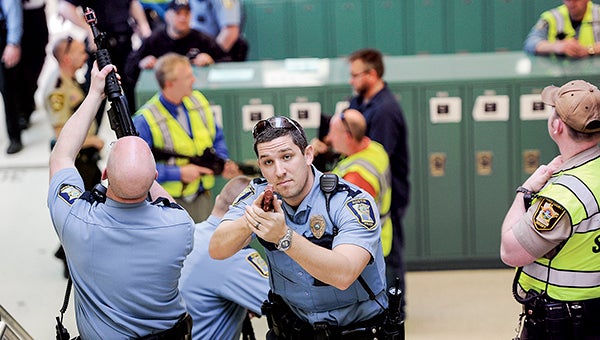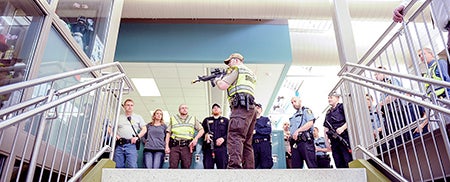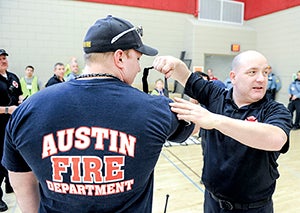Training for the worst; Mower emergency crews simulate disaster at I.J. Holton
Published 10:40 am Thursday, April 2, 2015

Austin Police officer Mike Hartman leads a trio of officers up the stairs at I.J. Holton Intermediate School Wednesday during active shooter and mass casualty training. — Photos by Eric Johnson/photodesk@austindailyherald.com
With weapons raised, three police officers walked up a stairwell at I.J. Holton Intermediate School Wednesday afternoon with one officer checking in each direction to clear the stairwell — or check it for an active shooter.
In another part of the building, firefighter Tim Olson demonstrated how to put a tourniquet on a wounded person as quickly as possible.
“Time is of the essence,” he told his fellow emergency responders.
But there were no real wounds to treat at I.J. Holton, no real victims to rescue and no criminals to arrest.
It was just a drill.
With students away on spring break, more than 80 emergency responders from across the county gathered at the school to train for an active shooter or a mass casualty event.
“Heaven forbid, if something like this actually happens, the training we’re conducting today is definitely going to help save lives,” said Mower County Deputy Evan Sorenson, who planned the training with Deputy Tim Donovan.

Mower County deputy Tim Donovan shows technique with a rifle before training began for clearing stairs Wednesday during active shooter and mass casualty training at I.J. Holton Intermediate School.
The training brought together responders from the Austin Police Department; Mower County Sheriff’s Office; Gold Cross Ambulance; Austin Fire Department; Grand Meadow, Adams and Lyle police departments; and several small-town fire departments.
“The main thing we wanted to come out of today was to get all the disciplines together — fire, EMS and police — training together to come together with a unified response, should something like this happen,” Sorenson said.
Emergency responders last completed active shooter or mass casualty event training about two years ago and typically complete training every other year or so.
The methods and tactics for such emergency responses are always changing. Each time a tragedy or incident occurs, investigations probe the event and response to see what could have been done for a better response and to potentially save more lives.
A good example of that is tourniquets.
Some responders admitted the general perception of tourniquets was once more negative, partially for fear of hurting a patient’s limbs. But they’re now considered a key life-saving tool. The military uses tourniquets far more frequently, and Olson said Austin firefighters are beginning to carry combat application tourniquets as part of their response gear.
If a main artery is severed, someone can bleed out in a matter of minutes. In studying past disasters, Olson said it’s believed that tourniquets could have saved lives.
“Our role as a rescue team is to identify patients that are savable, treat them effectively very quickly, and get them out,” Olson said.
Responders are now taking a “life over limb” approach; however, some responders said tourniquets have been left on for extended periods and people kept their limbs.
The lessons learned Wednesday would be used if there was ever a school or workplace shooting, an accident, or a weather related disaster. Sorenson said some tactics taught at a similar training session were used at a 2009 bus crash on Interstate 90 that killed two people and injured 21.
“It’s essential that we all train together so if this does happen, we’ll be able to save lives,” Sorenson said.
The training lasted from about 1 to 5 p.m., with three breakout sessions and a large scale response simulation. About 16 actors, mostly fire and police kids or law enforcement reserves, served as actors at the training.
Sorenson said I.J. Holton was a good location for the training since it’s Austin’s newest school.
“Children are our No. 1 priority and that’s why we chose to train here at I.J. Holton,” Sorenson said.



